Topics:
Never Miss a Beat - Get Updates Direct to Your Inbox
FILTER:
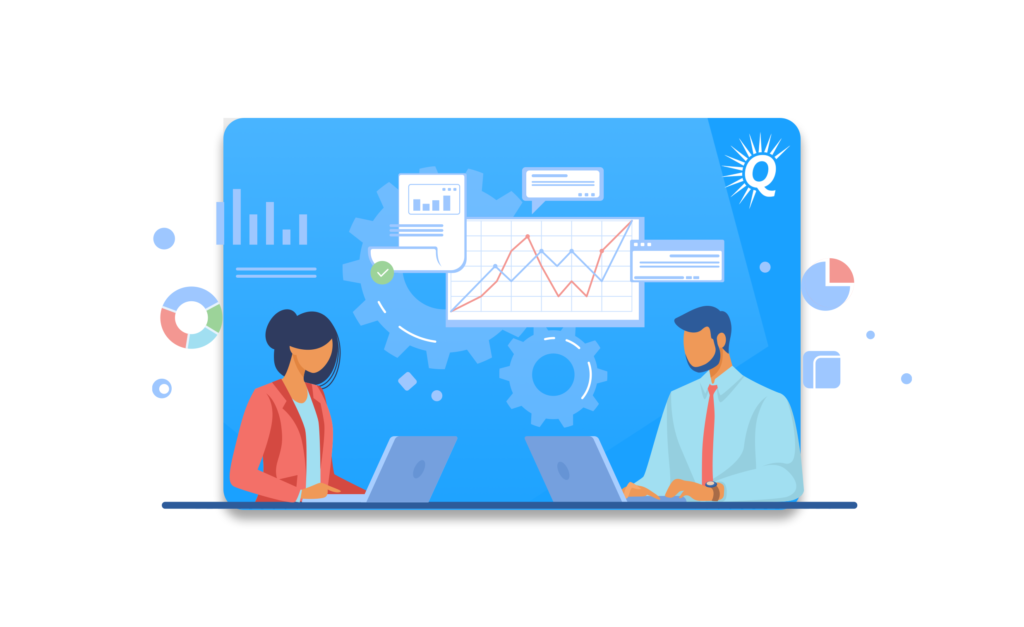

The Ecommerce Trends That Will Boost Your Conversion in 2021
By Quiet Light
eCommerce is one of the giants of consumer activity. Especially now, what with a pandemic at our door, purchases didn’t stop.
Instead, they went online. Retailers, supermarkets, any shop without an eCommerce store experienced a huge loss of conversion.
The year 2020 was full of surprises, most of which changed the eCommerce landscape completely and created different parameters that had to do with engagement, email marketing campaigns, and all of the CRO efforts of a brand.
The COVID-19 pandemic was responsible for some significant eCommerce changes across any niche, making people turn to new hobbies and goods they wouldn’t have considered before and changing the digital channels that convert:


As the graph above shows, email marketing is the clear winner, followed by referrals in each category. This comes as no surprise, but it still pinpoints how eCommerce has some trends and some staples that will rule in 2021 and beyond.
The eCommerce Conversion Rate You Need
You cannot do much if you haven’t decided on your KPIs – both as in metrics for customer satisfaction and your overall goals. These are what will form your campaigns and your marketing efforts, more or less.
By determining your goals and making them specific, measurable, attainable, relevant, and time-based, otherwise known as SMART goal setting, you don’t know what you’re after.
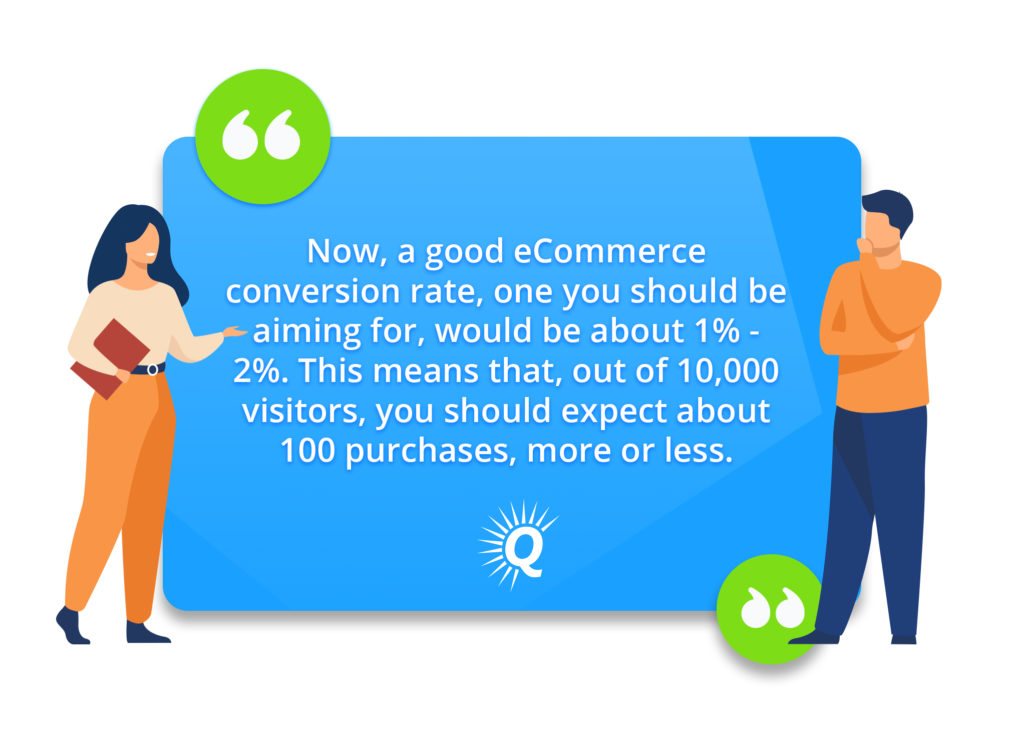

This means that you won’t know what you need to do, the time frame you need to do it in, you won’t even be sure whether or not your goal is attainable or something that you can’t complete in the specific time-frame you’ve set.
Now, a good eCommerce conversion rate, one you should be aiming for, would be about 1% – 2%. This means that, out of 10,000 visitors, you should expect about 100 purchases, more or less.
It may sound a little discouraging and counter intuitive – after all, why is eCommerce such a successful business if only 1% of customers go ahead with a purchase?
But if you prepare yourself and “ride the wave” on time – aka if you manage to set up a great digital marketing campaign as part of the way you’ll market your eCommerce business sooner rather than later – you’ll be able to master the eCommerce techniques and get the most out of the conversion rates.
And check this out:


The graph above is something every smart marketer needs to keep in mind. Paid and organic searches convert better because there is user intent behind them.
So, always keep in mind that eCommerce marketing doesn’t need to be just a Facebook campaign or an email marketing campaign. It can be way more than that.
A Responsive, Well-Curated Website
eCommerce marketing doesn’t stop at social media platforms. If your homepage and, by extension, your entire website isn’t optimized, you won’t get too far.
Keep in mind that most users are not looking for something specific when they’re browsing an eCommerce website. They’re looking for something that would catch their attention.


For example, the most recent search I made was “swimsuits 2021”. I could’ve ended up on the swimsuit section of an eCommerce website with clothing items or on the homepage of a website that sells swimsuits only.
Both happened, by the way.
This shows that users can and will arrive on your homepage, and your homepage needs to look great, enticing, and have some good SEO game going on.
If you’re unsure of that last bit, you can always trust the best eCommerce SEO services and have the experts work their magic.
Anyways, aside from that, don’t treat your homepage as a page that is there to show the categories your eCommerce store has to offer, and that’s that. A homepage’s job is to inform and ease the prospect into the selling process. For example:


This website has to do with jump ropes. That’s a little too niche. However, the amazingly calm and clean design and the look and feel of a homepage that isn’t too cluttered made me click on the “Show me the ropes” button.
Oh, and that CTA is some pretty clever wordplay, by the way.
This is exactly what I mean when I say “ease into the selling process”. There are not too many things that would capture the eye; there are enough for the steps to come naturally to the prospect.
Take notice of the buttons: There’s the CTA right front and center, the “Product” and “Reviews” on the top left-hand side, and a cart and a search button on the right. Nothing more, nothing less.
Thinking of Selling Your Business?
Get a free, individually-tailored valuation and business-readiness assessment. Sell when you're ready. Not a minute before.
Your homepage, and your website as a whole, need to lead the user down a certain path. It also needs to be optimized for mobile as well as desktop and be SEO friendly.
Don’t forget to optimize for long-tail keywords as well as the actual keyword you’re going for. For example, “jump rope brand that ships to Greece” could’ve been a nice long-tail keyword for me to use and stumble upon Crossrope’s website.
eCommerce and Hyper-Personalization
We spoke about it in 2020. We’ll be speaking about it in 2021 and beyond. Personalization is not just a fad. Certainly, hyper-personalization is something any brand should strive to achieve.


When crafting an email marketing message, marketers do their best to use tools to do their goals justice and help them reach their KPIs. This includes email templates that will “speak” to their audience, landing pages optimized to convert, automated emails triggered by the customer’s behavior on your website, and other tools that are parts of modern-day robust email marketing platforms.
However, these tools and tactics are nothing without personalization. Personalization isn’t so much a trend and could be dubbed “a necessity” in 2021 and beyond. And here’s why:
● More and more people base their purchases on the connection they can feel with the brands and with good reason.
● Prospects are moved by brands that “understand” them in some ways. This is only logical.
● Consumers are swarmed with ads, email campaigns, and various other marketing actions. They’re constantly looking for a brand that can make a difference.
You need to make something that pops, something that will allow your marketing efforts to make your eCommerce store shine.
So, how can you create a personalized email newsletter or marketing message?


Check it out; emails that are targeted get pretty much all of the attention. Therefore, make sure that you go through the following steps:
1. Segmenting is a life-savior. It will allow you to better understand your prospects’ needs. Create the segments you need, from the most classic, such as location or gender, to more in-depth, like purchase history.
2. Data from the behavior of customers on your website are also a life savior. Study those. You’ll be able to find a lot of useful information that will help you with the personalization and customization of your email campaigns.
3. Each serious action warrants a transactional email. Just get yourself an SMTP port and make sure to confirm all actions that need to be confirmed. That way, prospects will feel safe around your brand.
4. Use automated workflows and all information willingly given by the customer. Their name on the subject line is great, but a cart abandonment email or an onboarding sequence of emails is even greater.


Tools that implement AI will be the ones to help you out in this endeavor. AI can detect changes in patterns that will slip away from the human grasp.
eCommerce in Social Media: The Shoppable Ads
This is the newest trend in eCommerce, and, in all honesty, it’s not going anywhere.
The reason behind this is that social media platforms have turned from lead-gen, brand awareness machines to what many marketers refuse to acknowledge: Teeny tiny search engines, complete with pictures and everything.
As marketers, we constantly talk about the importance of social proof, UGC, and relatable posts. And here we are, needing these kinds of posts to boost our eCommerce digital marketing efforts. Here’s how:
Let’s assume that you want to somehow sell on Instagram and connect your account seamlessly with your eCommerce store. Like so:


(Source)
Erdem is one of my absolute favorite brands, both quality-wise and marketing-wise, as their brand’s tone is exactly what I would expect by looking at their products.
So, I went on Instagram and came across this post with the scarf you can see above. I was looking for scarves, to be honest, in Instagram’s Shop.
I clicked on the “View Product” button and saw the price. All good. But how am I supposed to buy it? Well, there’s a solution. Here’s what pops up if you click on the price tag:


Notice how you can access the website through Instagram? Now, if you click on the CTA button, you’re taken to the website. More specifically:


This eCommerce store offers a seamless multichannel experience. It incorporates digital marketing and bakes it into its own eCommerce store. That way, the prospect won’t lose interest or get distracted. This is the ideal function of shoppable ads.
You’re allowing the prospect to look for your product and shop through their feed or the app they’re using at that stage, seemingly directly.
Social shopping, shoppable ads, call it what you will, is here to stay. Just create a business account, upload your catalog, and start tagging products on posts. It’s very easy.
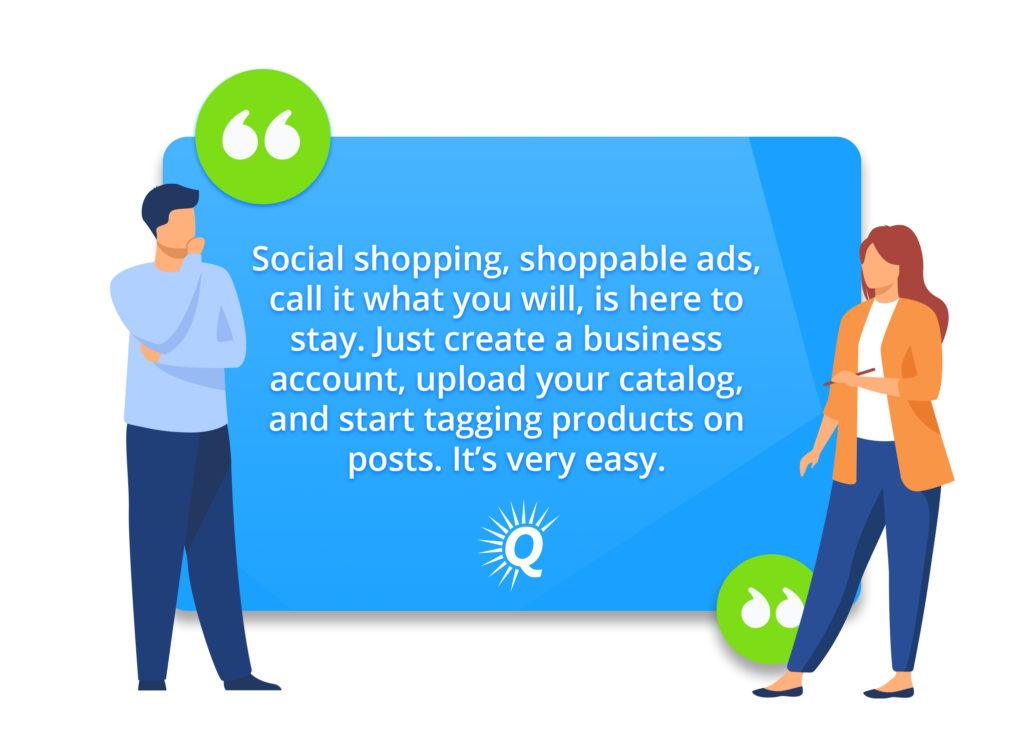

And most importantly, this practice creates zero friction. Just make sure your website is optimized for mobile. Remember, shoppable ads are not a feature visible on desktop, and you need zero friction to make this work.
Reviews: An Important Part of eCommerce Marketing
Now, let’s get to something a lot of people tend to overlook when it comes to eCommerce marketing: Reviews are a brand’s best friend.
You wouldn’t go to a restaurant you haven’t been to before without looking up reviews. Similarly, you’d never shop anything online, and you’d definitely never proceed with an online payment before doing some meticulous research and making sure you’re buying from a verified vendor.
And here is the truth of the matter:


Of course, prospects may love reading reviews, but not all customers are okay with writing them. Consider providing an incentive like a small discount or a sample product with the next purchase as a “thank you” for the buyer’s review.
A review serves as social proof, and as a trained marketer, you know how important it is for your business. Now, social proof in the form of positive customer feedback is something that can help your eCommerce store’s conversion rate grow.
But what about eCommerce digital marketing? Well, here’s where things get pretty interesting.
You can use all digital marketing channels to gather reviews for your eCommerce store. Utilize Facebook, Instagram and invest in tools that will help you manage your social media platforms.
There’s also one key thing to keep in mind, as evident in the statistic below:


Customers love a brand that cares enough to actually be polite and thanks them for their opinion. Even more so, when said brand responds to a situation that could potentially be harmful to the customer or the brand.
A fantastic way to ask for reviews would be through email marketing campaigns. Asking for one at the end of your transactional email just makes sense.
Send a follow-up email to make sure that the order has been received and everything went according to plan. Closing this email with a review request almost seems mandatory in order to do your eCommerce digital marketing strategy justice.
All in all, social media platforms and email marketing are the greatest places for one to leave a review. There are not too many things more reassuring than social proof, after all. Not even the ratings themselves.
Buy a Profitable Online Business
Outsmart the startup game and check out our listings. You can request a summary on any business without any further obligation.
eCommerce Marketing With Chatbots
Chatbots are way more than just an AI tool that can turn customer service into a piece of cake. They can be turned into lead-gen machines, selling machines, and sources of data.
Provided you follow through with the latest chatbots trends, of course. But you get the gist.
Chatbots could very well be your first ambassadors, those that will break the ice between you and the prospect. And don’t forget that their excellent service is what could turn a prospect into a customer.


You can see what a wonderful job this chatbot does, engaging and, in the end, converting the prospect.
All of that, simply by being available 24/7 and actually keeping the customer’s attention exactly where it needs to be: On the brand.
Chatbots carry all your data, can engage with information, answer questions and, most importantly, coax important information out of your prospect.
For example, by using a chatbot on a landing page, you increase interactivity. By increasing interactivity, you increase the time spent on the landing page.
Now, this increases the possibility of your prospect giving out their email address – provided they ended up on your landing page through an ad or a social media post. But it also increases rankings, boosts your SEO efforts, and, in the end, can increase the likelihood of a sale.
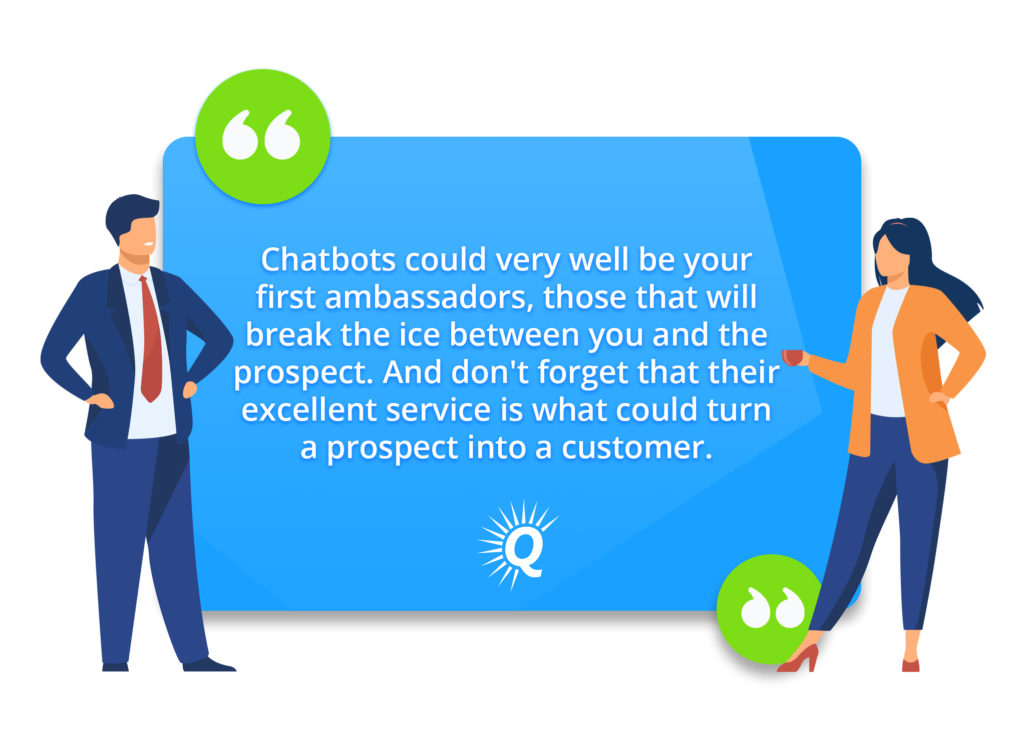

A chatbot can do yet another thing. It serves, as I mentioned at the beginning of this section, as an unlimited source of data.
I once chatted with the chatbot of a pretty big supermarket chain. I needed ingredients to make smoothies.
Guess who had an email in their inbox the next day, complete with a discount code and some offers for fresh fruit and frozen berries “ideal for smoothies”.
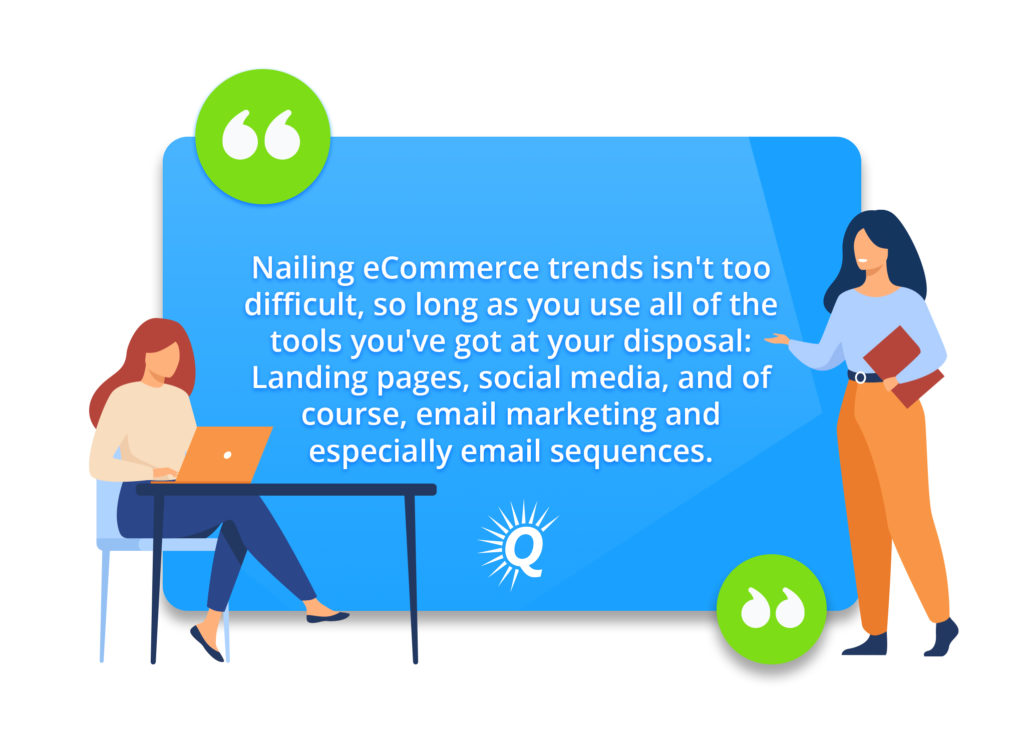

This is the kind of attitude you need when it comes to using your chatbots. Ultimately, this kind of attitude gave the supermarket a very quick, very rewarding sell, just because they made great use of the information I shared.
And Now What?
Before I go, I should point out that you’ll need some stellar email marketing strategy to push through and actually make a difference.
Nailing eCommerce trends isn’t too difficult, so long as you use all of the tools you’ve got at your disposal: Landing pages, social media, and of course, email marketing and especially email sequences.
That last one is what can keep a prospect faithful forever, from the first hello email to the last upsell and cross-sell email.
But no matter how you decide to approach the digital marketing aspect of your eCommerce store, you need to remember two things: A/B test always, and data comes first!
Author Bio:
Téa Liarokapi is a content writer working for email marketing software company Moosend and an obsessive writer in general. In her free time, she tries to find new ways to stuff more books in her bookcase and content ideas-and cats-to play with.





